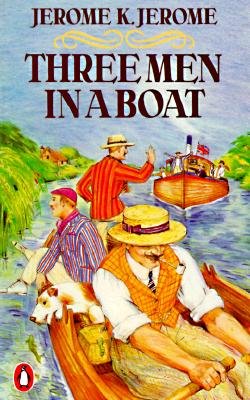It would also be a bad house for a drunken man to put up at. There are too many surprises in the way of unexpected steps down into this room and up into that; and as for getting upstairs to his bedroom, or ever finding his bed when he got up, either operation would be an utter impossibility to him.
We were up early the next morning, as we wanted to be in Oxford by the afternoon. It is surprising how early one can get up, when camping out. One does not yearn for “just another five minutes†nearly so much, lying wrapped up in a rug on the boards of a boat, with a Gladstone bag for a pillow, as one does in a featherbed. We had finished breakfast, and were through Clifton Lock by half-past eight.
From Clifton to Culham the river banks are flat, monotonous, and uninteresting, but, after you get through Culhalm Lock—the coldest and deepest lock on the river—the landscape improves.
At Abingdon, the river passes by the streets. Abingdon is a typical country town of the smaller order—quiet, eminently respectable, clean, and desperately dull. It prides itself on being old, but whether it can compare in this respect with Wallingford and Dorchester seems doubtful. A famous abbey stood here once, and within what is left of its sanctified walls they brew bitter ale nowadays.
In St. Nicholas Church, at Abingdon, there is a monument to John Blackwall and his wife Jane, who both, after leading a happy married life, died on the very same day, August 21, 1625; and in St. Helen’s Church, it is recorded that W. Lee, who died in 1637, “had in his lifetime issue from his loins two hundred lacking but three.â€Â If you work this out you will find that Mr. W. Lee’s family numbered one hundred and ninety-seven. Mr. W. Lee—five times Mayor of Abingdon—was, no doubt, a benefactor to his generation, but I hope there are not many of his kind about in this overcrowded nineteenth century.
From Abingdon to Nuneham Courteney is a lovely stretch. Nuneham Park is well worth a visit. It can be viewed on Tuesdays and Thursdays. The house contains a fine collection of pictures and curiosities, and the grounds are very beautiful.
The pool under Sandford lasher, just behind the lock, is a very good place to drown yourself in. The undercurrent is terribly strong, and if you once get down into it you are all right. An obelisk marks the spot where two men have already been drowned, while bathing there; and the steps of the obelisk are generally used as a diving-board by young men now who wish to see if the place really is dangerous.

